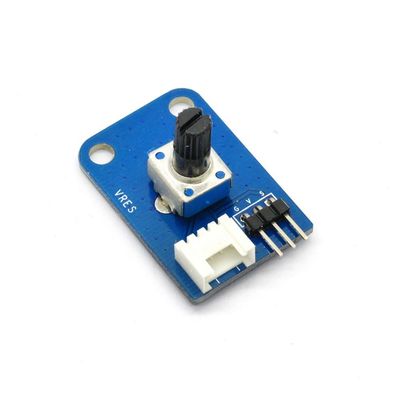Difference between revisions of "Rotary Potentiometer Brick"
(→Demo) |
(→Download) |
||
| Line 66: | Line 66: | ||
==Download== | ==Download== | ||
| + | [ftp://imall.iteadstudio.com/Electronic_Brick/IM120710014/DS_IM120710014.pdf Datasheet] | ||
| + | |||
| + | [ftp://imall.iteadstudio.com/Electronic_Brick/IM120710014/SCH_IM120710014.pdf Schematic] | ||
| + | |||
| + | [ftp://imall.iteadstudio.com/Electronic_Brick/IM120710014/DEMO_IM120710014.zip Demo Code] | ||
==Useful Links== | ==Useful Links== | ||
Revision as of 09:30, 27 May 2014
Contents
Overview
What is an electronic brick? An electronic brick is an electronic module which can be assembled like Lego bricks simply by plugging in and pulling out. Compared to traditional universal boards and circuit modules assembled with various electronic components, electronic brick has standardized interfaces, plug and play, simplifying construction of prototype circuit on one’s own. There are many types of electronic bricks, and we provide more than twenty types with different functions including buttons, sensors, Bluetooth modules, etc, whose functions cover from sensor to motor drive, from Ethernet to wireless communication via Bluetooth, and so on. We will continue to add more types to meet the various needs of different projects.
Electronic brick of rotary potentiometer can be connected to analog I/O port, and the analog value will vary accordingly when rotated to different positions.
Features
1.Plug and play, easy to use. Compatible with the mainstream 2.54 interfaces and 4-Pin Grove interfaces in the market.

2.With use of M4 standard fixed holes, compatible with M4-standard kits such as Lego and Makeblock.

Specifications
| PCB size | 36.0mm X 24.0mm X 1.6mm |
| Working voltage | 3.3 or 5V DC |
| Operating voltage | 3.3 or 5V DC |
| Compatible interfaces | 2.54 3-pin interface and 4-pin Grove interface(1) |
Note 1: S for analog output port, V and G for voltage at the common collector and ground respectively
Electrical Characteristics
| Parameter | Min. | Typical | Max. | Unit |
| Working voltage | 3 | 5 | 5.5 | VDC |
| Analog output voltage(VCC=5V) | 0 | - | 5 | V |
| Working current(VCC=5V) | - | 260 | - | uA |
| Resistance range | 0 | - | 10 | kΩ |
Hardware

Demo
Connect S port of electronic brick of rotary potentiometer to A0 port of Arduino board, and we will use the following program to read its analog value and set the brightness of LED lamp according to the value.
int brightness = 0; // how bright the LED is
void setup() {
// declare pin 9 to be an output:
pinMode(led, OUTPUT);
}
void loop() {
brightness = analogRead(A0); //use A0 to read the electrical signal
brightness = map(brightness, 0, 1023, 0, 255);
// set the brightness of pin 9:
analogWrite(led, brightness);
}
 Notice
Notice